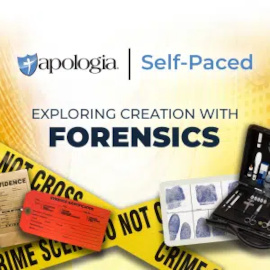Exploring Creation with Forensics is a self-paced, online course that should take one semester to complete. (The course is also offered as a live class through Apologia.) Lab activities completed offline qualify this as a lab course. The course is recommended for students in grades 11 and 12 who have already taken biology and chemistry.
The course reflects author Joseph Prahlow’s work and connections with law enforcement agencies. This is evident as he describes various forensic science applications and in the real-life photographic illustrations.
Written for Christian students, the course is based on biblical principles. For example, the first page of the digital textbook Introduction says,
When God created the world He not only made everything that can be known (the facts) but also all the tools we use to investigate it. These tools are the laws of nature, morality, and logic. Those are objective standards that cannot change and apply to all people in all places at all times, which is what makes them useful to weigh and evaluate evidence. That means it takes eternal truth to recognize earthly truths. And this eternal truth can only come from God.
Modules also include other Christian content, such as a “Case Notes” page with a connection to scripture.
The course components are the online self-paced course, the Exploring Creation with Forensics Student Notebook, and the Exploring Creation with Forensics Course Guide & Answer Key.
Online Course Components
The online course (on the Canvas platform) consists of lessons (with sections from the digital textbook, images, and videos), audio recordings of the textbook readings (done by AI), and automatically graded tests. Subscribing to the online course gives you access for one year. Parents can set up an Observer account, or they can log into their student’s account to check their progress.
The course is presented in 15 modules that should be completed at a rate of about one per week, with lessons three or four days per week. You should view or download the suggested schedule since it recommends different schedules for some modules, including two weeks for Module 8.
Each module has a video that reviews the module’s content in detail, but the videos do not follow the script of the textbook. Students should read the text and watch the videos. The textbook is presented in sections and includes illustrations. Students can watch the video either before or after reading the sections of the online textbook, whichever works best for them. Videos include some images that illustrate what the speaker is saying, but they often only show the speaker or display the words being spoken. Students watching the video might want to go back through the online textbook lessons to view images of what is described in the videos.
Near the end of most modules are career descriptions written by several people working in various areas of forensic science. Students aren’t tested on this information but might find it interesting.
Appendices for the online textbook include lab photos to be used in conjunction with some of the lessons, a comprehensive lab supply list, and a glossary.
The lessons sometimes include some troubling images from authentic crime scenes, so the course is recommended only for mature students. Even so, students can control the presentation of troubling images online with a feature that conceals them until a student is ready to view them and allows them to quickly close them.
Module tests are taken online. The first two tests allow students to take them open-book and retake them as many times as they wish. The tests for other modules are more restrictive, allowing students only two attempts.
Student Notebook
The 200-page, spiral-bound Student Notebook has pages for students to take notes, lab instructions, and lab worksheets for recording data and answering questions.
As students read and listen to the online textbook, they should take notes, ensuring they include the vocabulary words and definitions that are presented in a blue, boldface type. Students study these notes in preparation for tests.
Every module concludes with a lab activity, presented in the Student Notebook.
Course Guide & Answer Key
The Course Guide & Answer Key is for the parent or teacher. It explains the course briefly, but the bulk of the book pertains to the labs. It has lab setup instructions, lab answer keys, and a six-page “Complete Lab Supply List” that shows what is needed for each lab. (You can also access that list online before purchasing the course.) Many items might be readily available, such as permanent markers, a magnifying glass, human hair samples, animal hair samples, spinach leaves, and aluminum foil. Other items might take more effort to obtain, such as a microscope, animal bones, methyl alcohol, Methylene blue stain, and maggots. Consequently, Apologia offers a lab kit for this course that includes many of the non-household items, but not a microscope.
Many labs are what you would expect, with step-by-step instructions for experiments, accompanied by graphic organizers, and questions to answer. A few labs require students to do some math, but it should be manageable for students who have completed pre-algebra. Some labs use videos or other resources. For instance, the first lab, an observation activity, has students watch a clip from the movie It’s a Wonderful Life and answer questions afterwards to see how observant they were. For some labs, students analyze images or case studies, and some labs have optional extensions. In many cases, students use the experiments and evidence to determine the guilty party in a situation—practical applications of forensic science.
Course Content
The first module discusses the law and legal processes, as forensic evidence is often used in court proceedings. The rest of the modules each address a particular aspect of forensic science under the headings Fingerprints, Trace Evidence, Impressions and Toolmark Evidence, Toxicology and Chromatography, Firearms Examination, Death Investigation, Forensic Pathology, Forensic Anthropology, Forensic Odontology, Forensic Entomology, Bloodstain Evidence, Forensic Serology and DNA Testing, and Other Forensic Sciences. The last module covers the overarching topic, Crime Scene.
Summary
Exploring Creation with Forensics integrates several scientific disciplines and teaches real-life applications. It doesn’t fit neatly into the standard science course requirements. Students should already have taken biology and chemistry, so Forensics might be an elective course. However, students considering law enforcement careers will find that this course provides a solid understanding of various career options and the numerous scientific specialties available within the realm of forensic science.








